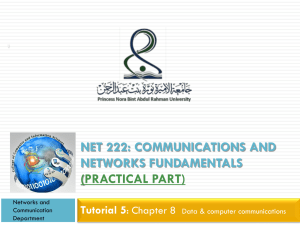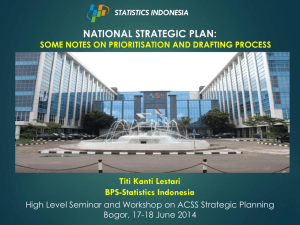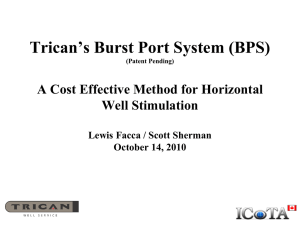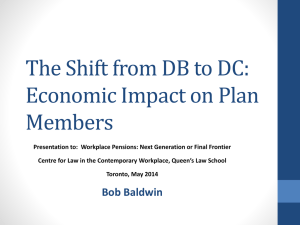A Comparison of Student Assignment Mechanisms
advertisement
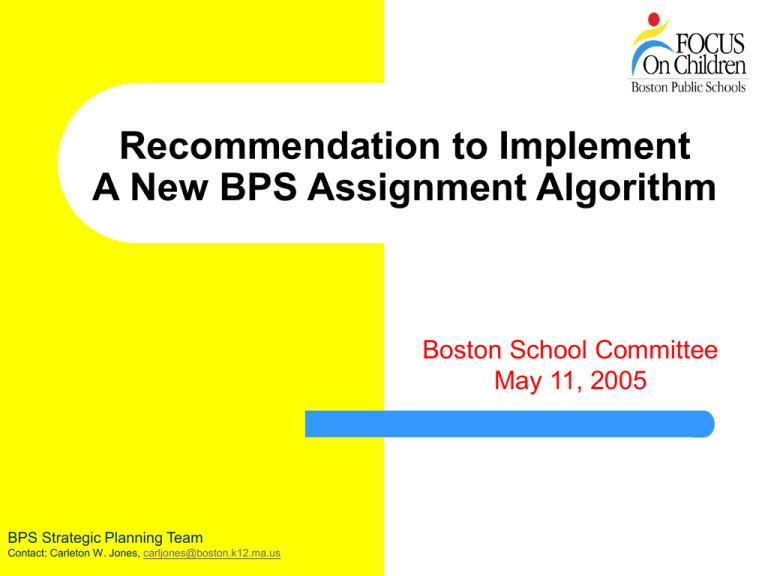
Recommendation to Implement A New BPS Assignment Algorithm Boston School Committee May 11, 2005 BPS Strategic Planning Team Contact: Carleton W. Jones, carljones@boston.k12.ma.us Contents 2 I. Impetus for Evaluating Current BPS Assignment Mechanism – The “Boston Mechanism” II. Review of October 2004 “Algorithm 101” Presentation to School Committee III. Report on Preliminary Findings of BPS Choice Data Study IV. Recommendation to Implement New Algorithm V. Next Steps I. Why Evaluate the Boston Mechanism? This is one part of a larger review to achieve a higher level of parental satisfaction and transparency in the outcomes of the student assignment process. In response to work done by a team of Economic Engineers on student matching mechanisms: – – – – 3 Atila Abdulkadiroğlu, Ph.D., Professor, Columbia University Parag A. Pathak, Ph.D. Candidate, Harvard University Alvin E. Roth, Ph.D., Professor, Harvard University Tayfun Sönmez, Ph.D., Professor, Koç and Harvard Universities BPS staff was convinced strategizing was likely occurring, to the detriment of students and families, during an October 2003 meeting with the economists. II. October 2004 “Algorithm 101” Presentation to School Committee 4 What is an Algorithm? Key Components of BPS Assignment Mechanism – Priorities – Preferences – Random Numbers Sample Case Study: Estella’s Assignment Issues With the Current BPS System Two Alternate Mechanisms What Is an Algorithm? An algorithm is “a set of ordered steps for SOLVING A PROBLEM, such as a mathematical formula or the instructions in a program.” – Computer Desktop Encyclopedia, © 1988-2004, Computer Language Company, Inc. In our case, the problem is to assign students to schools, while: – – – 5 Respecting each student’s PREFERENCES Adhering to each school’s PRIORITIES Making sure that each school is filled to its proper capacity Our solution: The Boston Assignment Mechanism -- the computer program that actually implements assignment policy. Key Components of Boston Mechanism Families have PREFERENCES for schools and make CHOICES – 6 Families HAVE CONTROL over their choices PRIORITIES order who gets assigned to each school – PRIORITIES are based on home address and sibling status – Families CANNOT control their priorities – BPS’ PRIORITY categories are: 1. SIBLING / WALK 2. SIBLING / NON-WALK 3. WALK 4. NO PRIORITY Here are the schools that Estella really wants: 1st choice: Murphy 2nd choice: Channing 3rd choice: Perkins Estella Estella’s True Preferences 7 Here are the PRIORITIES Estella has at each school: CHOICE SIBLING WALK RANDOM# MURPHY 1 NO NO 5 CHANNING 2 YES NO 5 PERKINS 3 NO YES 5 Estella’s Priorities 8 How the BPS Currently Assigns Students 1st Choice 2nd Choice 3rd Choice Sib-Walk Sib-Walk Sib-Walk Sib Sib Sib Walk No Priority As space is available Walk No Priority As space is available Walk No Priority Within each category, students are ordered by their random numbers 9 Where Estella’s Priorities Position Her for the MURPHY K-8 School 1st Choice Sib-Walk Students in 3 priority categories are ahead of Estella Sib Seats will be filled by students in 3 categories before reaching Estella Walk None 10 Estella The school may be filled by this point How it Looks for Estella at Each School MURPHY 1st Choice Sib-Walk Sib 11 CHANNING PERKINS 2nd Choice 3rd Choice Sib-Walk As space is available Sib Sib-Walk As space is available Sib Walk Walk Walk None None None Estella’s Perceived Chances Here is what Estella’s family believes are her chances of getting each school if they make it their first choice: 12 Chance Because? Channing Best chance Sibling priority. Medium Popularity. Perkins Good chance They live in the walk zone. Not Very Popular. Murphy Worst chance They have no priority. Very Popular. Estella’s Family Strategizes Here is how Estella’s family reorders their choices to ensure the best outcome given Estella’s preferences and priorities: 13 1st choice: Murphy Channing 2nd choice: Channing Murphy 3rd choice: Perkins The Problems With the BPS System 14 The current process forces families to STRATEGIZE. Strategizing is imperfect because families don’t know: – what their random number will be. – what schools other families are choosing. – how many others they’re competing with. Assignment becomes a high-stakes gamble for families. Undermines families’ trust in the BPS system. Families should not have to sacrifice their true preferences. Families should be able to be forthright about their choices. The system, not families, should compensate for mismatches between preferences and priorities. How It Looks Now for Estella at Each School CHANNING MURPHY PERKINS 1st Choice 2nd Choice 3rd Choice Sib-Walk Sib-Walk Sib-Walk Sib 15 As space is available Sib As space is available Sib Walk Walk Walk None None None Alternatives to Current Mechanism 16 Two alternatives that eliminate the need for strategizing are: – The Gale -Shapley Deferred Acceptance Mechanism – The Top-Trading Cycles Mechanism The BPS has been working with a team of economists who are experts on these alternatives These economists are helping the BPS explore the potential benefits of switching to one of these alternatives The Gale-Shapley Method Sibling-Walk 17 Sibling Walk No Priority 1st choice 1st choice 1st choice 1st choice 2nd choice 2nd choice 2nd choice 2nd choice 3rd choice 3rd choice 3rd choice 3rd choice 4th choice 4th choice 4th choice 4th choice Estella With Gale-Shapley Method Sibling-Walk 1st choice Sibling 1st choice Walk No Priority 1st choice 1st choice MURPHY 2nd choice 2nd choice 2nd choice 2nd choice 3rd choice 3rd choice CHANNING 3rd choice 3rd choice PERKINS 4th choice 18 4th choice 4th choice 4th choice Gale-Shapley Method 19 Orders students by priorities and by choices, without discarding ANY choices or priorities Uses ITERATIVE method - searches back and forth to put each student into TOP-MOST choice without sacrificing the priorities of other students Allows students to choose their True Preferences without potentially being penalized by selecting a highly chosen school as their first choice Gale-Shapley Method Pros & Cons PRO: 20 Considers all priorities and preferences throughout the whole assignment process Eliminates the need for families to strategize CON: Considers priorities more strongly than 1st choices Is not focused on providing the highest percentage of 1st choices Estella With Top Trading Cycles Method Estella has a priority to the CHANNING, which Frank wants, and Frank has a priority to the MURPHY, which Estella wants, so the system lets them TRADE. Now each gets a seat at their 1st choice school Estella CHANNING 21 Frank Priorities & Positions Will Be Traded MURPHY PERKINS CHANNING (1st) MURPHY (1st) PERKINS Top Trading Cycles 22 Starts with the highest priority students at the schools. Students either keep the seat if it’s at their top choice school, or trade it. Students who want to trade priorities are allowed to do so. This means that, when two students want schools that the other has the higher priority for, they can trade their priorities with each other in exchange for a seat in each other's schools. Allows students to choose their True Preferences without potentially being penalized by selecting a highly chosen school as their first choice. Top Trading Cycles Pros & Cons PRO: CON: 23 Allows students to trade priorities for top choice seats Eliminates the need for families to strategize Can have the effect of “diluting” priorities’ impacts, if priorities are to be “owned” by the district, as opposed to being “owned” by parents Could lead to families believing they can strategize by listing a school they don’t want in hopes of a trade. Comparison Between BPS, G-S and TTC BPS 24 Rewards Strategizing? Holds ‘Place in Line’? Strongest Driver: Rewards True Choices? YES NO FIRST NOT CHOICE ALWAYS GaleShapley NO YES PRIORITIES; ANY CHOICE YES Top Trading Cycles NO YES TOP CHOICES; TRADING YES III. Report on Preliminary Findings of BPS Choice Data Study 25 In April 2005, our team of economists presented a preliminary report of findings from their study of the potential impact of changing the BPS student assignment algorithm from a priority matching algorithm to one of the two proposed strategy-proof algorithms. The economists ran the three algorithms, based on the actual school choices made by BPS parents from 1999-2003 Summary Of Key Findings 1. 2. 3. 26 The analysis of choice data from SY1999-2003 indicated that: – Many families take the risk of choosing an over-demanded school into account when making school selections. – Many families mitigate that risk by selecting a “safety” school as their second choice. – Many families who do not adequately take this risk into account receive worse assignments than they otherwise could have. The adoption of a strategy-proof algorithm, when holding current choice patterns constant, does not significantly change the outcome of the assignment process while removing the risk of ranking schools in simple order of preference. Adopting a strategy-proof algorithm would: – Eliminate the need for parents to “strategize” in ranking school preferences -- allowing parents to rank schools in order of true preferences without having to consider the popularity of the desired school – Diminish the harm done to parents who do not strategize or do so well. Under Each Algorithm, Still 74% or Higher of Students Receive Their First Choice School Using Actual BPS Choices (SY01-02) 80% 78% 80% 79% 78% 77% 77% 75% 76% 75%75% 74% 74% 72% 70% Grade K2 27 Grade 6 Grade 9 Current Gale-Shapley Top Trading So Why Change? A Comparison of the Three Algorithms 28 The percentage of students receiving their ‘first choice’ using the Boston Mechanism is overstated, as compared to the two alternate mechanisms. – Initial evidence and theory suggests because of some level of strategizing, currently students are only receiving a high percentage of their stated first choices. – Students are not receiving a high percentage of their true first choices. (i.e. “where they rather go” vs. “where they think they can get in.”) This deficiency will be completely removed under a strategy-proof algorithm as it responds to a student’s true choices, and not their strategized choices. A Smaller Percentage Of Over-demanded Schools Are Ranked As Second And Third Choices Grade K2 (SY01-02) 100% 90% 80% 70% 60% 50% 40% 30% 20% 10% 0% Likely “Safety” Schools 52% 67% 74% Other** Over-demanded* 48% 33% 26% 1st Choice 2nd Choice 3rd Choice 29 *Based on previous year’s choice figures. **’Other’ includes times when no 2nd or 3rd choice is made. Example: Lyndon Receives Far Fewer 2nd and Higher Choices Than 1st Choices, Compared to Trotter Grade K2 (SY01-02) 160 140 151 1st – 3rd Choices more evenly distributed at Trotter 120 100 80 60 40 34 45 31 30 24 11 10 8 7 4th Choice 5th Choice 20 0 1st Choice 30 Lyndon Trotter 2nd Choice 3rd Choice Seat Capacity: Lyndon = 50 Seats, Trotter = 51 Current Situation: First Choice, First Served 31 The Boston Mechanism looks at everyone’s first choice school first, and assigns based on priorities and random numbers. If a student is not assigned during the first pass, they face the likelihood of having their 2nd, 3rd and even 4th choice schools filled if the family selects overdemanded schools that other’s have made their first choice. Under The Current Algorithm, Parents Who Are “Risk Takers” Often Suffer Roughly 45% of students who received their third choice or lower would have benefited from removing an over-demanded school as their top choice. Example: A parent made the following choices: 1. 2. 3. 4. 5. 32 Young Achievers…...(Over-demanded, with limited number of seats) Timilty Harbor McCormack Lewenberg….(Assigned School) Because of an average lottery number, this student was not assigned to Young Achievers, but instead was assigned to the 5th choice school, the Lewenberg. This “Risk Taker” Could Have Done Better In our example, if the parent had removed Young Achievers as a first choice and moved up all other choices, the same lottery number would have secured a spot in the Timilty. The parent would have gotten the Timilty: 1. 2. 3. 4. 33 Timilty…….(originally, the number 2 choice) Harbor McCormack Lewenberg Anticipated Outcomes of an Algorithm Change: 34 1. The adoption of a strategy-proof algorithm (GaleShapley Deferred Acceptance Mechanism or the Top Trading Cycles Mechanism) will take the high-stakes gamble out of the assignment process. 2. Since a strategy-proof algorithm eliminates the need for strategizing, parents will no longer be discouraged from putting a more popular school as their first choice. Selection habits will change, and fewer students are expected receive their first choice school if more people are vying for seats in overdemanded schools. Anticipated Outcomes of an Algorithm Change: 35 3. The number of school choices made by families is likely to increase, as parents will be more inclined to list all schools they are interested in, not just those to which they are more likely to gain admittance. 4. BPS will have to effectively inform families of the algorithm change and actively encourage them to choose from eight to ten schools (at the elementary level) on their application forms. 5. A family submitting a short list of highly chosen schools will dramatically increase their chances of receiving an administrative assignment. Conclusion 36 The current BPS assignment algorithm makes it risky for parents to rank an over-demanded school first, unless they have a high priority at that school. A Strategy-Proof Algorithm: – Removes the risk from ranking schools in order of true preference. – Eliminates the need for strategizing. – Adds “transparency” and clarity to the assignment process, by allowing for clear and straight forward advice to parents regarding how to rank schools. – “Levels the playing field” by diminishing the harm done to parents who do not strategize or do not strategize well. IV. Recommendation: Gale-Shapley 37 The Gale-Shapley Deferred Acceptance Algorithm will best serve Boston families, as a centralized procedure by which seats are assigned to students based on both student preferences and their sibling, walk zone and random number priorities. Students will receive their highest choice among their school choices for which they have high enough priority to be assigned. The final assignment has the property that a student is not assigned to a school that he would prefer only if every student who is assigned to that school has a higher priority at that school. Regardless of what other students do, this assignment procedure allows all students to rank schools in their true order of preference, without risk that this will give them a worse assignment than they might otherwise get. Why Not Top Trading Cycles? 38 The Top Trading Cycles Algorithm allows students to trade their priority for a seat at a school with another student. This trading shifts the emphasis onto the priorities and away from the goals BPS is trying to achieve by granting these priorities in the first place. This trading of priorities could lead families to believe they can still benefit from strategizing, as they may be encouraged to rank schools to which they have priority, even if they would not have put it on the form if the opportunity for trading did not exist. The behind the scenes mechanized trading makes the student assignment process less transparent. V. Next Steps 39 Presuming the School Committee agrees with changing the algorithm, the Committee would engage in a public process to present the findings and rationale for making the change. BPS staff will develop a strategy for implementing an algorithm change for the SY06-07 registration process, that begins in January 2006. The implementation strategy will include: – After further determining the extent of the effort required to program the new algorithm, a plan to complete the change by December 2005. – A comprehensive communications plan that will inform parents of the algorithm change and how best to make their school choices. Questions? 40
